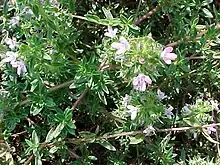| Thymus herba-barona | |
|---|---|
 | |
| Scientific classification | |
| Kingdom: | Plantae |
| Clade: | Tracheophytes |
| Clade: | Angiosperms |
| Clade: | Eudicots |
| Clade: | Asterids |
| Order: | Lamiales |
| Family: | Lamiaceae |
| Genus: | Thymus |
| Species: | T. herba-barona |
| Binomial name | |
| Thymus herba-barona | |
Thymus herba-barona is a species of thyme native to Corsica, Sardinia, and Majorca. It is also sometimes known by the common name caraway thyme, as it has a strong scent similar to caraway, for which it can be used as a substitute in any recipe. It can be used in cuisine or as an evergreen ground cover plant for the garden.
There are two subspecies:
- Thymus herba-barona subsp. herba-barona. Corsica, Sardinia
- Thymus herba-barona subsp. bivalens. Majorca (Spain)
Description
Caraway thyme is a creeping, woody-based perennial, growing to 10 to 25 cm (4 to 10 in) high and spreading out across the ground to a width of 30 cm (12 in). The leaves are 4 to 10 mm (0.2 to 0.4 in) long, lanceolate, dark glossy green and hairy. The foliage has a strong aroma of caraway. The flowers are pink with four petals and a prominent lower lip. They are produced in late spring and early summer, and are attractive to bees and butterflies.[1]
Cultivation and uses
Caraway thyme grows best in average soil with light watering and full sunlight. The plant was favoured in England as a seasoning for barons of beef; this inspired its scientific name. It is cultivated in gardens across the world. Caraway thyme is difficult to grow from seed, so it is usually purchased as young plants 5–10 cm high, in small pots.
Caraway thyme contains an essential oil and the plant has antiseptic, deodorant and disinfectant uses. It also has uses in perfumery, as a mouth wash and as a traditional medicine.[2] A study undertaken to compare the essential oil with similar oils from two other members of the genus found that all three had similar antimicrobial activities against gram-positive bacteria and against mycetes as compared to the well known antiseptic chlorhexidine gluconate.[3]
References
- ↑ "Thymus herba-barona". Missouri Botanical Garden. Retrieved 2013-12-10.
- ↑ "Thymus herba-barona". Plants for a Future. Retrieved 2013-12-10.
- ↑ Juliano, Claudia; Mattana, Antonella; Usai, Marianna (2000). "Composition and in vitro Antimicrobial Activity of the Essential Oil of Thymus herba-barona Loisel Growing Wild in Sardinia". Journal of Essential Oil Research. 12 (4): 516–522. doi:10.1080/10412905.2000.9699578.